If you are eager to experience China’s high-speed train, how can you miss this 10 days China train tour! On this tour, you will have a chance to take reliable, speedy, and comfortable high-speed trains to different cities. On the China train tour from Hong Kong, you will see the traditional and modern scenery of the city by a visit to its attractions like the Tai O Fishing Village and the Victoria Peak. Then, you will take a high-speed train to Chongqing, where you will have an opportunity to taste local delicacies in Ciqikou Ancient Town and enjoy crusing the Yangtze River. At last, on the train tour to Shanghai, you will have a wonderful experience in this fashionable city by a visit to the Bund, Yu Garden, and Nanjing Road. At the same time, you can take the world’s fastest elevator to visit the Shanghai Tower. Come and join us! Discover the unknown with the high-speed train!

Welcome to Hong Kong. Hong Kong’s total land area and sea area amount to 1106.66 and 1648.69 square kilometers respectively. With a population of about 747,400, Hong Kong is one of the most populated cities worldwide. It is also home to famous attractions like the Lantau Island and the Victoria Peak, which we are going to visit in the next few days. Our guide will hold your name sign and wait for you at the airport, and then accompany you to the hotel.
Free Time Suggestion: If you are bored in the hotel, going to the Lan Kwai Fong at night is probably a good choice. It is home to different pubs and restaurants, where you can have a drink and chat with locals. Most of the people in Hong Kong can speak English fluently. Accordingly, there is no need to worry about language barriers. You can also go to a lively music bar to relax where you can dance with others accompanied by the live performance of musicians.
This morning, we will drive you west for about 36 minutes (34 KM) to visit Lantau Island. It is the largest island of its kind in Hongkong and it is almost double size of the next largest one: the Hong Kong Island. Upon arrival, we will take the Ngong Ping 360 Cable Car for about 25 minutes to visit the Big Buddha. During this period, you will be excited since you can take this opportunity to get a bird’s eye view of many sceneries, including the whole Lantau Island and the Hong Kong-Zhuhai-Macao Bridge. You may marvel at the length of the Hong Kong-Zhuhai-Macao Bridge, which serves as the world’s longest cross-sea bridge. When you get off the cable car, you will see the Big Buddha, the world’s highest outdoor bronze seated Buddha with a height of 26.4 meters. Just one of its fingers is as tall as two people’s height. Though it is tall, you can still see many knots on its head. Don’t look down upon these knots. They are not only decorations but also lightning rods. The Big Buddha is located in a thunderstorm-stricken area. Therefore, in order to protect the Big Buddha from damage, advanced science and technology are used to design knots as lightning rods. How novel and innovative!
Then we will visit the Po Lin Monastery. Walking into the Po Lin Monastery, you will see many halls, including the Grand Hall of Ten Thousand Buddhas and the Main Shrine Hall of Buddha. The architecture of the Main Shrine Hall of Buddha conforms to that of the Forbidden City, the imperial palace for the 24 emperors during the Ming (1368-1644) and Qing (1644-1911) Dynasties. It has a yellow glazed tile roof with a hip-and-gable style. In front and at the back of the Main Shrine Hall of Buddha stand eight octagonal stone pillars respectively, with the carved coiled dragons. And there is an architrave with colored drawings between every two pillars.
After that, we will go to see the Tai O Fishing Village. What kind of transportation does your family use in daily life? Bicycle, public bus, or family car? In modern society, most families have nothing more than these three means of transportation. But in the Tai O Fishing Village, you will see a totally different transportation - the Sampan. Why is that? It boils down to locals’ exceptional water shanty lifestyle. It is said that the ancestors of the local people were banished to live on the water for punishment. Later, Yongzheng, the 3rd emperor of the Qing Dynasty, allowed them to live in the villages near the water. However, some of them were used to living on the water and did not move away. The house that enables them to live on the water is the water shanty, a type of stilt house. Do you know how to build the water shanty? First of all, two-or-three-meter-high wooden pillars will be inserted directly into the water. Next, planks will be laid on top of them. At last, the house will be built with timber as the way people put up the shed on the land. Most of water shanty just have one or two floors, because the wooden pillars cannot support much weight.

 Chongqing
Chongqing After breakfast, we will go to Victoria Peak, the highest point in Hong Kong. A panoramic view of Hong Kong is available here. There is a giant heart-shaped brand “Say I Love You at the Peak”, which has witnessed a lot of romantic relationships, friendships, and emotional attachments among family members as well. If you want to get to the peak, you should take the Peak Tram for about 10 minutes. The Peak Tram will provide you with a different experience of climbing. As the Peak Tram climbs from 28 meters to 396 meters above the sea level along the slope, the trees and tall buildings on both sides seem to be going backward. At this time, you can take out a mobile phone or camera to record this memorable visual experience. But you should watch out for balance since your body will also tilt backward naturally.
The terminal of the Peak Tram is the Peak Tower designed by British architect Terry Farrel. He got the design idea of its shape from the bowl and the gesture of salute with hands folded (Traditionally in China, we put the right hand over the left and bow slightly when we greet someone). The shape of the Peak Tower is so unique that its image is widely used by millions of postcards around the world. In addition, the Peak Tower enables visitors to enjoy the panorama of Hong Kong. In the east wing of the Peak Tower, you can overlook Victoria Harbor, a natural harbor in Hong Kong. And in the west wing, you can even see Lantau Island, the attraction we visited yesterday.
After lunch, we will go to the train station to take the estimated train G320 14:49/22:20 to Chongqing. Our local guide will transfer you to the hotel. If you are tired, you can have a good sleep on the train because China’s high-speed train is very stable. A lot of people have proved this by standing coins on high-speed trains. And the coins can keep their balance for nearly 5 minutes. If you are curious, you can try it with a coin or an upside-down water bottle.
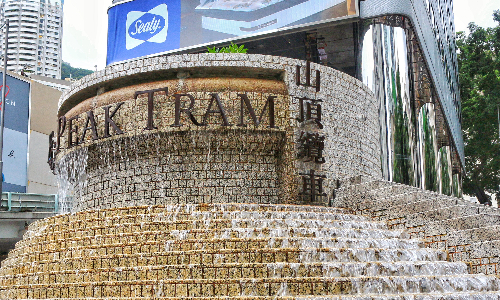

Good morning. Today, our trip will begin with the Ciqikou Ancient Town. Built in the Song Dynasty (960-1279), the town has a history of more than 1,000 years. It features traditional southwestern Chinese architecture. In addition, the town boasts of its variety of unique local foods like Maoxuewang, a dish of boiled blood curd and entrails with spicy sauce. Every dish has its own legend, as does Maoxuewang. It is said that in the Republic of China (1912-1949), a butcher would sell pig entrails at a reduced price after selling out meat every day. His wife thought that was a money-losing business. For this reason, she began to make soup with pig entrails and sell them at a higher price. By pure chance, she added pig blood curd in the soup. But she did not expect that pig blood curd cooked more tender and entrails became more delicious. Since then, she has begun to sell the soup with pork entrails and blood curd, which is the original Maoxuewang. If you are interested in this dish, you can have a try when you visit Ciqikou Ancient Town. Of course, many other delicacies are waiting for you to explore.
After lunch, we will come to see the Hongya Cave. It covers an area of 46,000 square meters, which is equivalent to the size of 6 soccer fields. There are 11 floors in the Hongya Cave and the 1980s Street is located on the fifth floor. Walking into 1980s Street, you may feel like traveling through time and getting back to the 1980s to see China at that time. You can catch sight of many old objects, including old TV. There is a wall with old TVs and radios. Have you ever seen an old TV? There is a wire on its head to receive signals. Compared to the color TV in modern times, the old one can only show the black-and-white pictures. In addition, people would rotate the buttons on the TV to change channels and adjust the volume in the past while these days people would use the remote control to do the same things. Maybe you can try to rotate the button on the old TV on the wall. You may be surprised that it could work. Because the old TV here is not a counterfeit but a real one.
After visiting the Hongya Cave, you will be transferred to the dock to board the Yangtze River cruise ship. The Yangtze River is the longest river in China as well as the third-longest one in the world, next to the Nile River in Africa and the Amazon River in South America. It rises in the Tanggula Mountains at Qinghai-Tibet Plateau, which is known as the roof of the world. With a length of more than 6,300 kilometers, it wanders across 11 provincial areas from east to west and empties into the East China Sea. Its drainage area is about 1.8 million square kilometers, accounting for 1/5 of the land area of China.

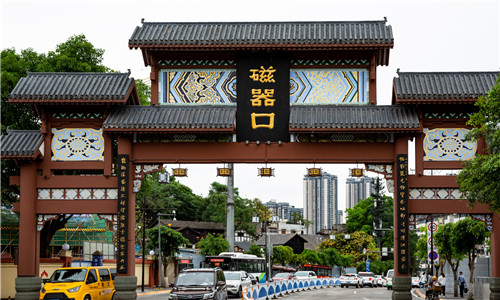
Today, our first stop is the Shibaozhai Pagoda. It is located at the north bank of the Yangtze River in Zhong County, Chongqing. There are 12 layers in the Shibaozhai Pagoda. There are vivid relief sculptures of Chinese mythologies on its gateway, one of which is about Nezha’s Triumph Against Dragon King. Legend has it that senior general Li Jing garrisoned at Chentangguan Pass, a place in the northwest of present-day Sichuan Province. Nezha was his third son. Nezha liked martial arts since childhood and took an immortal as his master to learn martial arts. One day, when he was playing with his friends by the sea, he saw the third son of the dragon king physically abusing children and slaughtering innocent people. He was swollen with righteous indignation and stood up to fight with the dragon’s son. Finally, Nezha killed the dragon’s son and pulled out his tendons. Facing the news of his third son’s death, the dragon king went into a rage and decided to take revenge. The dragon king was in charge of the rain, so he tried to inundate Chentangguan with a continual rain of 3 months. Hating to see the people suffering for him, Nezha cut his own throat. But his master brought him back to life and gave him two magic weapons to make him more powerful. Finally, Nezha caught the dragon king and broke his palace, getting rid of an evil for the people.
Our next stop is the Fengdu Ghost City. This is an optional tour which needs to pay an extra fee if you plan to get it. Fengdu Ghost City has a history of more than 2,000 years. To restore the nether world in Chinese mythologies, many related structures were built like the Bridge to Hell. According to Buddhism, people will suffer from transmigration which means the dead person’s soul will pass into another body after death. The Bridge to Hell is just one stop on the path to transmigration. The immortal Mengpo will stand on the Bridge to Hell with the soup she made. Anyone who wants to get into the transmigration must drink a bowl of soup which will make him forget everything before he died. After that, his soul can pass into another body and start his new life.
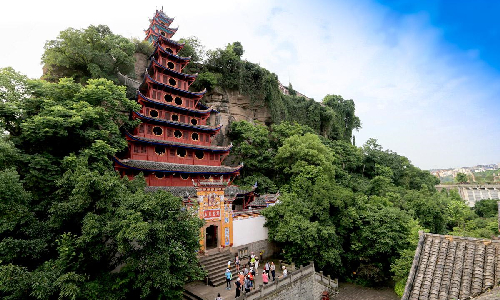

After breakfast, you will visit the Qutang Gorge. With a length of about 8 kilometers, it is the shortest of Three Gorges. Therefore, tourist attractions are concentrated here, which is convenient for travelers. On the south bank, you will see the Fenbi Wall, a thousand-meter wide stone wall into which numerous characters were carved with different Chinese calligraphic styles. You can appreciate four calligraphic styles here: semi-cursive script, regular script, the official script as well as seal script.
Next, you will visit the Wu Gorge. As the second-longest gorge in Three Gorges, it is 46 kilometers long. On its north and south banks, there are majestic and splendid twelve peaks. Among them, the Goddess Peak is the most beautiful one since its shape is like a slim and graceful girl. Legend has it that in ancient times, the overflowed Yangtze River led to severe flooding. After seeing the devastation caused by the flood, a goddess named Yaoji descended to the mortal world to help people control flooding. After eliminating flooding, Yaoji decided to stay here to protect the local people, and then she became a rock standing beside the Yangtze River. Now, people call it Goddess Peak.
And then you will pass by the Xiling Gorge. With a length of 66 kilometers, it is the longest gorge of Three Gorges. It is mainly composed of smaller gorges and dangerous shoals. From east to west, there are five gorges, including Military Books and Precious Sword Gorge, Ox Liver and Horse Lung Gorge, Kongling Gorge, Yellow Gorge, and Lantern Shadow Gorge. You may find that their names are very funny even a little strange, in particular the name of the Ox Liver and Horse Lung Gorge. As a matter of fact, it gets its name for two yellow rocks here with the shape of ox liver and horse lung respectively. And they are stalactites precipitated by calcium carbonate. Nowadays, the ox liver rock is still complete but the horse lung rock has been damaged in the war during the Qing Dynasty.


 Shanghai
Shanghai Today you will visit the Three Gorge Dam. It is the largest hydropower station in the world. It takes 17 years, from 1993 to 2009, to build the dam. The Three Gorges Dam Scenic Area combines water conservancy culture with the natural scenery of the Yangtze River. Here, you can learn more about the Three Gorges Dam in the exhibition hall. You can also climb on the 185 Observation Deck to visit the dam up close and overlook the spectacular scenery of the Yangtze River.
After visiting the Three Gorge Dam, you will be transferred to the visitor center. Our guide will wait for you there to drive you to the train station. You will catch the estimated train D2208 14:55/23:15 to Shanghai. People are less liable to carsickness in China fast train than in a bus. At the same time, it is also big on security, with a higher speed and lower prices. Therefore, it has become one of the most common and favorable means of transportation in China. Your tour guide will help you get on the train. You can take a rest or enjoy nice views along the journey. The guide in Shanghai will be waiting for you and take you to the hotel. Your visit in Shanghai will start tomorrow.
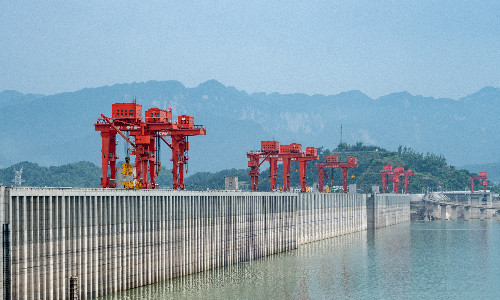

Today, our trip will begin with the Jade Buddha Temple. Built in the Qing Dynasty, it has a history of more than 100 years. Master Huigen is the founder and the first abbot of the Jade Buddha Temple. When he was young, he liked traveling the world. When arriving in Myanmar, he saw a great deal of jade with excellent quality. An idea of purchasing beautiful jade to carve Buddha statues occurred to him. Then he began to seek funding. The King of Myanmar is a Buddhist. After hearing the news, he allowed Huigen to get the jade for free. Finally, Master Huigen obtained 5 huge and high-quality jade and carved them into five jade Buddhas. Now, the Jade Buddha Temple houses two of them: the sitting Buddha and the reclining Buddha.
After visiting the Jade Buddha Temple, you will come to see the Yu Garden (closed each Monday). Built in the Ming Dynasty, it was originally a private garden and was not open to the public until 1961. There is a Dragon Wall in the Yu Garden. It is the enclosing wall decorated by 5 huge dragons with 3 or 4 toes on each of its claw. The dragon, in ancient Chinese mythologies, has 3 to 5 toes on each claw. You may wonder why dragons here only have 3 or 4 toes. The reason is that the dragon with 5 toes on each claw refers to the emperor and only can be used by the emperor. If anyone else uses the dragon with 5 toes as decoration pattern in their house, he will be treated as a person who is irreverent to the emperor. Therefore, the artisan just used the dragon with 3 or 4 toes.
After lunch, you will come to see the Shanghai Tower. There are 133 floors with 127 floors on the ground and 5 floors under the ground. The Top of Shanghai Observatory, where you can have a comprehensive view of Shanghai, is on the 118th floor. Can you imagine that it will take you less than 1 minute to get to it? Do not be surprised. The Shanghai Tower is home to the world’s fastest elevator, with a maximum speed of more than 40 miles per hour (around 64 kilometers per hour). Its speed is double that of the normal elevator. So you can get to the Top of Shanghai Observatory in just 55 seconds.
Then, you will come to see Nanjing Road. It is the first commercial street after Shanghai opened up its port for trading. It is lined with flagship stores of many famous brands like Apple and M&M’s. There are only 5 flageship stores of M&M’s in the world. They are located in New York, Las Vegas, Orlando, London and Shanghai separately. And in this flagship store of M&M’s on the Nanjing Road, you will see the world’s longest M&M’s candy wall, on which there are long and thin jugs with M&M’s chocolate in different colors and tastes. In addition, there are also kinds of related products in the store such as M&M’s T-shirt and bag. I sure you will find something you like here.
After that, you will head to the last destination today: the Bund. With a total length of 1.5 kilometers, it is home to 33 classical buildings, one of which is Shanghai Pudong Development Bank, formerly known as the HSBC Building. It is the largest and most magnificent building on the Bund. The British at the time praised this building as the most luxurious building from the Suez Canal to the Bering Strait. In front of its entrance stand two copper lions. These two copper lions are an important symbol of the HSBC Building. The lion that opens its mouth and roars is named after A.G. Stephen, general manager of the Hong Kong branch of HSBC; the other lion that closes its mouth and ponders is named after the manager of the Shanghai branch of HSBC – G. H. Stitt.

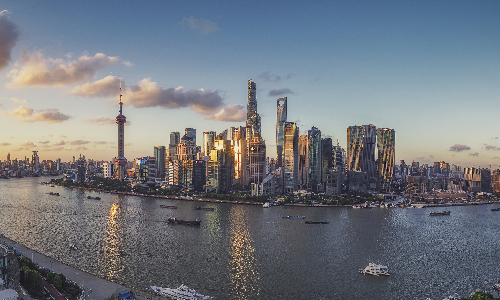
After breakfast, we will drive you southwest for about 55 minutes to the Zhujiajiao Water Town, which is 48 kilometers away from the Shanghai downtown area. It is a traditional Chinese water town. There are historic stone bridges, quaint houses, exquisite pavilions and so on. Boating on the river, admiring the ancient buildings in the water town, and feeling the history and culture here are the favorite project of many guests. There is a famous bridge named Fangsheng Bridge in the water town. The Chinese character “fangsheng” means freeing captive animals. Every year on the lunar New Year’s Day, the local monks would hold the solemn ceremony beside the bridge and free live fish to the river with the aim to show respect for life.
After lunch, we will drive back to the city’s downtown area to visit Tianzifang Market. Before 1988, Tianzifang was just a small bazaar. Later, the government rebuilt Tianzifang. After reconstruction, Tianzifang became a gathering place for restaurants, handicraft shops, art galleries, and coffee shops. Here you can buy all kinds of Shanghai souvenirs, such as silk scarves or ties, local White Rabbit Toffee, skin care products used by Shanghai women in the last century, and so on. Pick one or two to bring back to your friends, I am sure they will love it.
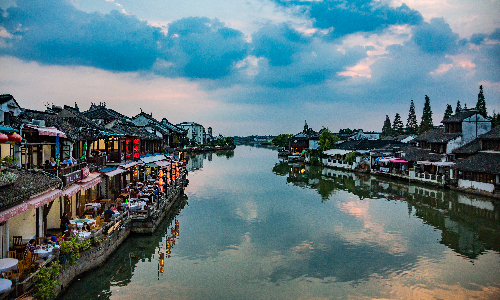
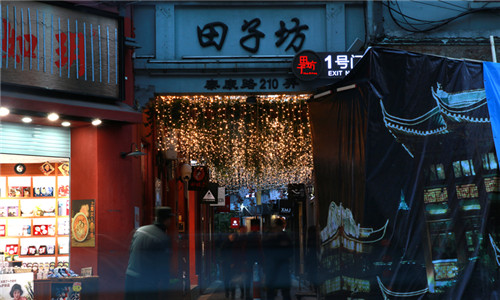
Your high-speed train tour will come to an end after today’s breakfast. You will be transferred to the airport according to your flight schedule and the guide will help you check in. Have a nice trip.
Author: Junyan Cao
Proofreader: Betsy He
| City | Five Star hotel list | Four Star hotel list |
|---|---|---|
| Hong Kong | Harbour Grand Kowloon | Harbour Plaza North Point Hotel |
| Chongqing | Hilton Chongqing | Yangtze Island Hotel Chongqing Jiefangbei Walking Street Branch |
| Yangtze River Cruise | Victoria Anna | Victoria Anna |
| Shanghai | Ocean Hotel Shanghai | Courtyard by Marriott Shanghai Central |
 |
![]() About your child or infant, please contact us for a discounted price.
About your child or infant, please contact us for a discounted price.



We started with a few days in Beijing & ended in Shanghai, from where we visited the Forbidden City and Great Wall. In between we visited Terra Cotta Warriors Museum, Panda Base, Shanghai Disneyland.

We had a wonderful holiday in China which will remain long in the memory. China is a breathtakingly beautiful country full of splendid temples and palaces, mountains and rivers, peaceful rural scenes and bustling shopping streets.
 QUICK ENQUIRY
QUICK ENQUIRY